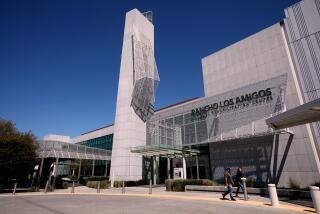The doctor canât see you now
Three months ago, I finished my last 30-hour shift as a medical student. Although Iâll be starting my residency soon, itâs unlikely Iâll ever again work such a marathon shift.
FOR THE RECORD:
Physicians: In a Jan. 24 Op-Ed about residency funding, the Accreditation Council for Graduate Medical Education and the Assn. of American Medical Colleges were incorrectly called the American Council for Graduate Medical Education and the American Assn. of Medical Colleges, respectively. â
Last fall, the American Council for Graduate Medical Education released new standards governing the nationâs 111,000 physicians in training. In the most controversial reform in the recent history of medical education, these celebrated overnight rites of passage for rookie docs will soon join the ranks of bloodletting and barber surgeons in medical antiquity.
In an attempt to decrease errors and improve patient safety, the new standards restrict the consecutive hours a first-year resident may work without sleep, from the customary 30 to 16. Meanwhile, experienced residents are limited to 24-hour shifts, with a recommendation to pursue âstrategic nappingâ in downtime.
The measures are well intentioned but controversial. Critics fear that shortened shifts will increase the number of physician-to-physician handoffs that occur as residents change shifts, resulting in lost details and miscommunication that could cause errors and harm patients. Continuity of care is desirable because of the advantages of having a single physician caring for the same patient over time. Others charge that 16-hour shifts are insufficient for educational purposes.
Surprisingly, research evidence supporting duty-hour regulations is lacking. Even the council concedes that the 80-hour limit on the resident physician workweek, instituted in 2002, failed to yield conclusive effects â positive or negative â on patient outcomes, though researchers acknowledge this is a challenging metric to assess. Both sides of the debate offer compelling, albeit unproven, arguments championing patient safety.
Although I share concerns regarding the effect on patient care of more frequent handoffs, I certainly did not labor through medical school only to end up harming a patient because of my fatigue.
However, this impassioned debate overlooks a more insidious issue that may pose an even greater threat to patient well-being. Although young doctors work long hours for traditional and educational reasons, staffing requirements further underpin the argument for 30-hour shifts and 80-hour workweeks. The problem is simple: We have too many patients and too few doctors.
Provided it survives legal and legislative challenges, the healthcare reform law extends insurance coverage to 30 million Americans. And aging baby boomers are expected to double the population of elderly by 2030. Will we have enough doctors to accommodate them?
A June 2010 report issued by the American Assn. of Medical Colleges says no. In a model that accounts for the influx of newly insured patients, increasing utilization of doctor visits, decreases in physician working hours, modest growth of the resident workforce and greater use of nurse practitioners and physician assistants, a 130,600-physician shortage is anticipated by 2025, half of which will be primary-care doctors.
Even now, it can be challenging to find a primary-care doctor accepting new patients, and the current estimated shortage is only 7,400. Imagine the task in 2025.
Resuscitating the physician workforce requires collaboration between medical schools, professional organizations and government. Medical schools now are kindling interest in primary care and aiming to boost enrollment by 30% before 2018. For the first time since the 1960s and 1970s, new medicals schools are being built. However, these new graduates will need residency programs to complete their training.
Few realize that these residency programs are mostly funded through Medicare and other government programs, and since 1997, the number of federally supported positions â and thus the annual number of freshly credentialed doctors â has been capped by Congress.
The health reform package includes admirable efforts to address physician shortages: improved funding for the National Health Services Corps, which trades student loan repayment for care rendered in underserved areas; payment incentives and training opportunities for primary-care doctors; and grants to medical schools to develop rural training programs.
However, lawmakers failed to increase the number of federally funded residency positions. Instead, they redistributed the number of unused slots in less-desirable training programs to more deserving hospitals that promise to train mostly primary-care and general surgery residents. A reasonable first step but one that amounts to a temporizing measure, not a cure.
Congress must lift the cap on residency funding to avert an imminent compromise of our physician workforce. The coming shortage will overwork doctors, both young and old; delay necessary patient care; and negate any potential safety gains afforded by new training regulations and future reforms. Medical school and residency training can last seven to 11 years, so prompt intervention is required to augment next decadeâs workforce.
Universal healthcare will succeed only if there are enough physicians to render it.
Bradley Wertheim, a student at Harvard Medical School, will begin his residency in internal medicine in July.






